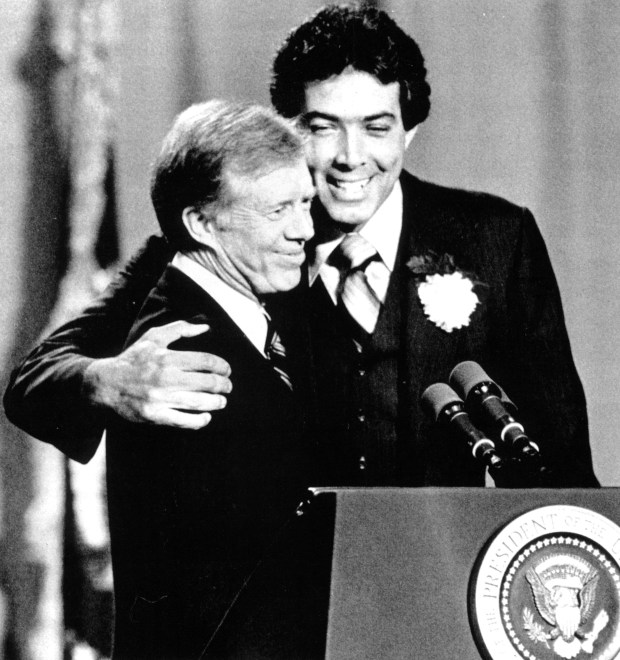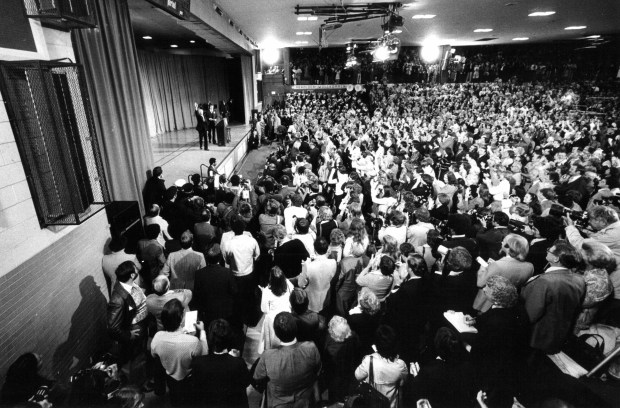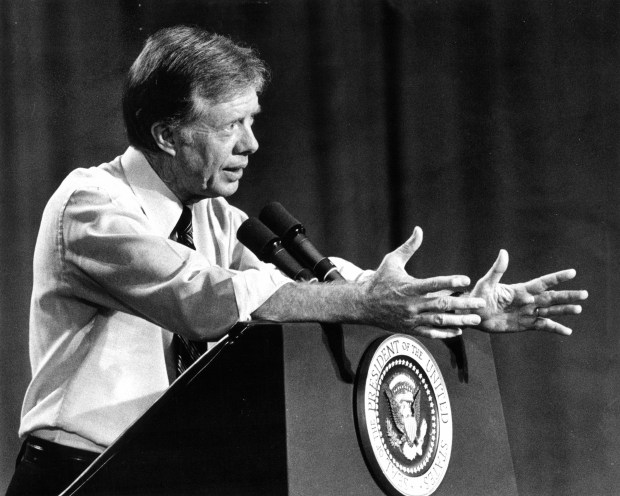When he arrived by helicopter at Thornridge High School in Dolton the morning of Oct. 16, 1979, Jimmy Carter’s election to a second term as president was no certainty.
Fewer than a third of voters approved of his performance, and it would be just a few weeks before 53 American diplomats and citizens were taken hostage in Iran. Carter was also trying to battle rising inflation and gas lines.
Adding to his troubles to gain a second term, Massachusetts Sen. Ted Kennedy would formally announce his campaign Nov. 7 to challenge Carter for the Democratic nomination.
When he spoke at the high school Carter had celebrated his 55th birthday a few weeks earlier on Oct. 1
Carter marks his 100th birthday Tuesday and is the oldest living U.S. president. He entered hospice care in February 2023 after a series of hospital stays.
His wife of 77 years, Rosalynn Carter, died last November, just days after entering hospice care.
As Carter hits the century mark, some people who were at the Thornridge event recalled the large crowd and enthusiastic welcome that greeted the Georgia peanut farmer 45 years ago.
Inside the Thornridge gym, students, teachers and community members had assembled for a Town Hall meeting. Carter’s daily diary indicated he spoke to about 2,500 people.
Bill Bero, who grew up in Dolton and graduated from Thornridge in 1970, was covering the visit as editor of the Sun-Journal newspaper in Lansing.
“It was just surreal to see the crowd, the massive crowd, the gym was overwhelmingly packed to the rafters,” Bero said. “It was something else to behold.”
It was an invitation-only event, and Thornridge sophomore Richard Lanting stood outside as a helicopter ferrying Carter and newly elected Chicago Mayor Jane Byrne touched down on a field outside the school.
Lanting, now living near Champaign, said he shook hands with Carter and Byrne as they walked into the school.
“I reached out my hand and he grabbed it,” Lanting said. “I don’t recall if he said anything to me or if I said anything to him.”
“It was really cool. I mean, how many people have been able to shake the president’s hand?” Lanting said.
Inflation was pushing over 14% and homebuyers faced double-digit mortgage rates. The president’s approval rating that July had sunk to 28%, according to the Gallup Organization.
Byrne, elected that April, was not a supporter of Carter and would back Kennedy through the primaries.
The president and Byrne were greeted by then-U.S. Rep. Marty Russo along with District 205 Superintendent William Augustus and Thornridge Principal Salvatore Salato, according to Carter’s itinerary.

During the visit, broadcast live by Chicago TV stations, Carter was peppered with questions about the economy, runaway inflation and whether he backed the idea of wage and price controls. He spoke for more than an hour.
Carter said the U.S. had to cut back on its ties to overseas oil supplies and instead work to increase oil and gas supplies domestically, and use solar and synthetic fuels along with energy conservation, to address energy costs, according to a transcript compiled by The American Presidency Project at the University of California at Santa Barbara.
A Thornridge student, Harvey Harris, asked the president what he planned to do about rising gas prices, the transcript shows.
Carter noted the U.S. had no control over the price of oil the country brought from overseas, and “what we must do is to cut down on our over dependence on that oil.”
“So, what we want to do is to cut down on imports and produce more energy in our own country,” he said, according to the transcript.
Carter said he hoped families would gather and talk about how they could curb their energy use.
“The more we save, the better off we all are,” the transcript shows him saying.
Carter talked about goals of using more coal and solar to supply the country’s energy needs, and that carpooling and the shift toward smaller, more fuel-efficient cars would help the U.S. wean itself off foreign oil.
He said that U.S. car companies were also at work on an experimental electric vehicle that used batteries and would travel about 100 miles on a charge.
John Viero was a freshman at the time whose father worked for Russo’s campaign and was able to secure tickets.
Viero said he, along with his parents, were able to sit fairly close to the president.
“It was a very energetic meeting,” he said. “There was genuine enthusiasm for him and the event.”
Bero said Carter was “friendly and warm and smiling” and “got thunderous applause.”
“He exuded warmth,” said Bero, who lives in northwest Indiana. “It was a good feeling to have experienced it.”
Scott Kuzminski was at the Town Hall session, tasked with writing a report for the student newspaper at Mount Carmel High School.
He attended freshman year at Thornridge before transferring to Mount Carmel, and was able to get time off from school.
“The deal was I had to do a report for the school newspaper,” he said.
“It was an extremely warm reception,” said Kuzminski, who was in his senior year. “People were just so happy that he came to the school.”
“He was comical, he was very engaging,” Kuzminski said. “He was upbeat, very lighthearted.”

Afterward, Carter and Byrne were driven to the Harvey Holiday Inn, since demolished, where they spoke with Cook County Democratic officials, including George Dunne, then party chairman, and John White, chairman of the Democratic National Committee, according to Carter’s daily diary.
He addressed about 110 people in the hotel’s Regency Ballroom before being driven back to Thornridge, where he got back on Marine One for a flight to O’Hare International Airport, leaving the school shortly before 1 p.m.
Viero said he was among a number of people still waiting outside the school when Carter returned.
“Everybody hung around because Marine One was still in the field,” he said.
Viero, who lives in Lemont, said he watched as the helicopter took off.
“It was a really neat memory,” he said.
With the general election looming in 1980, inflation remained stubbornly high, gas prices had not eased and a failed rescue attempt of the Americans held hostage in Iran all combined to doom Carter’s bid for a second term.
Republican Illinois Congressman John Anderson mounted an independent campaign that garnered nearly 7% of the popular vote, or 5.7 million ballots cast. In the 1980 general election, Carter received 41% of the popular vote to a bit more than 50% for Ronald Reagan.
Lanting lived in South Holland at the time of Carter’s visit and said, in retrospect, Carter “did so much for a lot of people” after leaving the White House.
Kuzminski said he considered Carter to “be very good as a president,” but that “he was more appreciated afterward, with things like his work for Habitat for Humanity.”
Noting factors such as inflation and high oil and gas prices, he said Carter “had too many things hit him at once.”
“Looking back on the event it’s very different from what I see on TV today, with maybe 100 people,” Viero said.
“He may have not been handed the best deck of cards for a presidency but I think he was genuinely a good guy,” Viero said.




